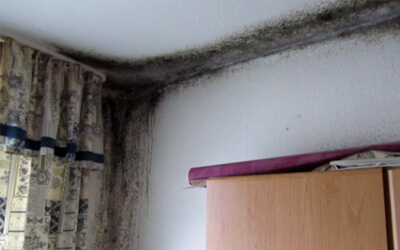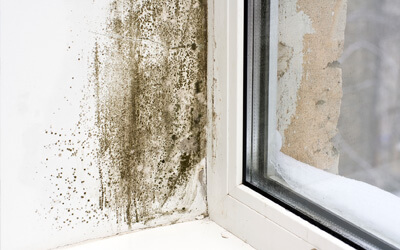
The causes of mould infestation
Nutrients and moisture
Mould can develop in living spaces if nutrients and sufficient moisture are present. Structural factors, especially in combination with incorrect ventilation and heating behaviour or lack of technical ventilation, favour mould growth. Moisture then mostly appears in the form of condensation on the colder building components. Thermal bridges, e.g. in the area of the window reveal, the upper room corner on the outside wall or behind the cupboard standing close to the outside wall, are the most common types of damage. In addition, there is damage caused by direct moisture penetration of the masonry due to leaking roofs, cellars, pipes or averages.
The determination of causes
Moisture measuring devices, data loggers and calculation methods are available to experts for determining the cause. In practice, it has been shown that the interaction of several factors is often the cause of mould infestation in living areas. To ensure that mould does not form again within a very short time, it should be clarified in advance of the renovation what the cause of the damage is.
Cause check
Below you will find some of the common causes of mould infestation.

Furniture on the outside wall

Pipeline damage

Flood damage

Facade not intact

Missing insulation

Rising damp

Pressing dampness

New building damp

Thermal bridges

Ventilation behaviour
Prophylaxis through FAKOLITH mould protection paints with BIO.FILM.STOP technology
Particularly in the rental sector, it is not always possible to eliminate all causes or even to completely renovate living areas. In this case, painting ceilings and walls with the interior wall paints FAKOLITH FK 5, FAKOLITH FK 10 and DISPERLITH HYGIENIC is absolutely recommended as prophylaxis. The innovative BIO.FILM.STOP technology demonstrably protects the colour film of the vapour-diffusion-open professional colours against mould and bacteria infestation.

Professional mould sample analysis
We offer you the examination and evaluation of samples taken from the object. You will receive a well-founded laboratory report including the determination type and the classification of the intensity of the microbial infestation. We recommend the use of the test slides we provide for this purpose. Detailed information on laboratory analysis can be found here.

Application technology / advice
If you cannot find the right product for your requirements in our product portfolio, if you have questions about selected products or if you would like further advice, please feel free to call us personally or send us an e-mail.
Telephone: +49 (0)6253 / 23 94 – 18
Consultation hours: Monday to Friday 7.30 a.m. – 12.00 p.m. and 1.00 p.m. – 4.00 p.m.
E-mail: anwendungstechnik@fakolith.de
